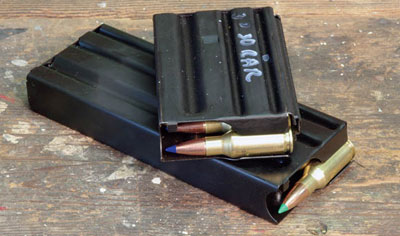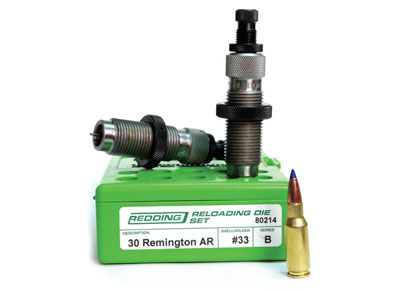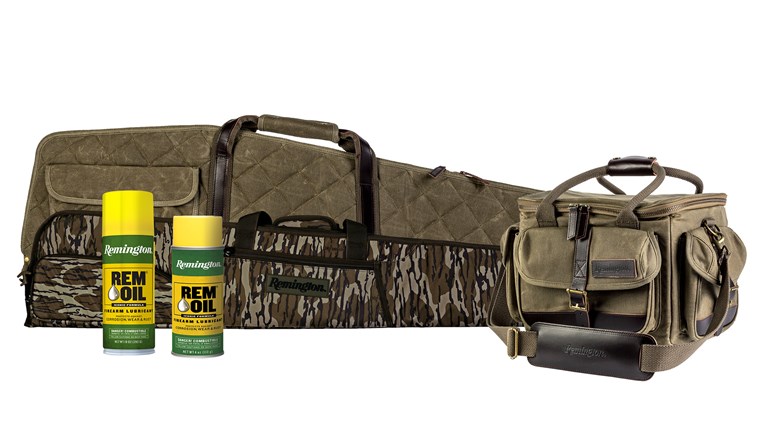
There is a surprising overlap in cartridges designed for hunting and tactical use that runs both ways. Military cartridges often find great acceptance in the hunting world, like the .30-'06 Sprg.—first designed as a battle cartridge, it has found a home with hunters.
Over in the southbound lane, the .300 Win. Mag. was designed by Winchester for hunting, but is now becoming a preferred cartridge for military snipers. It seems you simply cannot predict the path a cartridge will take based solely on its original intended use.
AR-15-specific cartridges are more good examples. Although designed for war, the 5.56 NATO/.223 Rem. has found widespread acceptance in military, law enforcement and civilian circles. Today it is used for shooting bad guys, wild game and targets.
The 6.8 Rem. SPC was also designed as a battle cartridge for the M4. It was conceived to give our fighting forces more power than the 5.56 NATO, which for almost 50 years has endured criticism for its ineffectiveness. The 6.8 Rem. SPC failed to catch on with the military, but it's been kept alive by civilians for defense and hunting.
So all this leads to some questions: What does the world have in store for the newest AR-15 cartridge, the .30 Rem. AR? Does it have any tactical application? We know it will kill deer, but is it something you should consider for personal defense?
The problem with cartridges for the AR-15-type rifle is length. The rifle's design limits the overall length of the cartridges it can handle. SAAMI-approved maximum overall cartridge length for .223 Rem. is 2.260 inches, and the AR platform doesn't allow anything much longer.
When looking for a harder-hitting cartridge, the traditional solution has been to increase bullet diameter, as in the .450 Bushmaster or the .50 Beowulf. That approach results in a big, heavy bullet with moderate muzzle velocity. It works for shooting big game up close and even has some tactical applications. For example, a tough, heavy bullet from a Beowulf is the best you can put in the AR-15 platform for busting up things that make motors run.
But for the most part, these big-bore cartridges have very limited tactical application. They might be OK for a close-range firefight, particularly when the bad guys have armor, but recoil is stiff and magazine-capacity limitations keep the number of shots available without a reload to nine for the .450 Bushmaster and 10 for the .50 Beowulf.
There have been some attempts to find middle ground with cartridges like the 6.8 Rem. SPC and 6.5 Grendel. Both are good choices, but limited in bullet weight and energy. Also consider that the most successful cartridges throughout history, military and civilian, have been .30-caliber options. While this bullet diameter has been largely bracketed on both sides in AR-15 cartridges, no mainstream .30-caliber cartridge has emerged.
I suppose you could argue for the 7.62x39 mm, but it's designed to run in an AK-47, not an AR-15. The AK has its magazine well built into the magazine, while the AR's is in the rifle. That means the last few inches of an AR magazine must be straight. The tapered cartridge body of the 7.62x39 mm does not play well with a straight magazine. A 7.62x39 mm magazine should be the same as the opinion most men hold about women: curves are a necessary part of the design.
Did the world even need a new .30-caliber AR cartridge? The brain trust at Freedom Group thought it did. Freedom Group owns leading AR manufacturers Remington and DPMS. It mandated the ammunition folks at Remington to come up with the cartridge and the gun guys at DPMS make it work in an AR-15.
Freedom Group also owns Bushmaster—as in .450 Bushmaster. The .450 Bushmaster is based on the .284 Win. case with a rebated rim; straightened out and shortened to fit in an AR-15. Remington took the .450 Bushmaster case, shortened it some more and necked it down to a .30 caliber. It added a slightly larger rim diameter to prevent using the .450 Bushmaster cartridge in the rifles and switched the case to a small rifle primer. The result is called the .30 Rem. AR, and it's the first .30-caliber mainstream cartridge designed specifically for the AR-15.
DPMS engineers found a way to use the larger AR-10 bolt in an AR-15. They also modified the magazines to feed the short, fat bottleneck cartridges. Surprisingly, it was the magazines that gave them the most trouble. But, it all worked and the two were married in a formal ceremony held at Freedom Group headquarters complete with a cake and Ted Nugent playing "Wango Tango" for their first dance.
OK, I made that last part up—they never made it legal, but they did mate.
Remington took the cartridge public at its October 2008 writers' seminar. However, the company was a bit premature. Glitches along the way kept it out of production for a while, but I got my hands on a prototype DPMS upper and some engineering sample ammunition in 2009. While both had problems to be worked out, I was impressed with the accuracy and the ballistic potential. By mid-2010, Remington was finally shipping R-15 rifles and DPMS soon followed with uppers in .30 Rem. AR.
The R-15 rifle is made by DPMS for Remington. It is finished in Advantage MAX-1 HD camo, except for the barrel and a few select parts, and has a 22-inch blued barrel with a 1:10-inch twist rate. The barrel has shallow, short fluting in front of the gas block.
There are no sights on the flattop gun, but the gas block has a rail on top for mounting iron sights. The trigger, like all the R-15 rifles I have tried, is atrocious, but that's easily fixed with a drop-in replacement. The gun has an aluminum floating forearm, an A2-style full-length buttstock, a plastic A2-style grip and comes with a four-round magazine.
DPMS sells uppers in .30 Rem. AR, but to avoid infringing on the gun sales of its sister company, it doesn't sell complete guns. Its offering has a 20-inch barrel with a 1:10-inch twist. The flattop upper is finished in black.
I have worked with both the Remington R-15 rifle and a DPMS upper and have shot them extensively at the range with factory fodder and handloads. In fact, I wrote a handloading feature for Hodgdon's "Annual Manual" reloading guide on the .30 Rem. AR, as well as a handloading article. As a result, I spent a lot of time shooting these rifles through my Oehler Chronograph. I also took the R-15 to Wyoming, where I filled my freezer with three pronghorn antelope and helped control the coyote and prairie dog populations on the ranch. I witnessed the .30 Rem. AR taking seven different antelope and was able to trace bullet channels through them all. So, I can claim a good amount of trigger time with the guns and an idea of the round's terminal performance.
Currently, Big Green is the only source of factory ammunition. It offers four loads, including a 123-grain FMJ at an optimistic catalog-advertised muzzle velocity of 2,800 fps. My chronograph showed considerably slower velocities than expected with all the factory ammo—the FMJ loads averaged 2,610 fps in my guns.
While the main advantage of an FMJ is the lower price, the reason the military uses FMJ ammo is because of The Hague Convention of 1899. It prohibits the use in warfare of bullets that easily expand or flatten in the body. Only politicians could come up with a treaty that says it's OK to shoot the enemy, but you must use bullets that don't hurt as much. Civilians protecting their homes and families are not bound by those foolish rules and have little tactical use for FMJ ammo other than for practice.
There are two, 125-grain expanding-bullet loads. The first is an AccuTip bullet advertised at 2,800 fps. This is a polymer-tipped bullet that expands both easily and rapidly. I used it and watched it used on multiple antelope, coyotes and prairie dogs from a .30 Rem. AR. It would be my first choice for home defense with factory loads due to its rapid expansion and short penetration.
The other 125-grain load is a Core-Lokt Pointed Soft Point bullet with a claimed velocity of 2,880 fps. This is also a soft, cup-and-core-style bullet. It has a slightly lower ballistic coefficient than the AccuTip, but it should also make a good defensive load. Finally, Remington recently added a 150-grain Core-Lokt load with a touted muzzle velocity of 2,575 fps. This load was introduced in response to demands from deer hunters who desired a heavier bullet. For hunting applications it is far superior.
The light bullets were selected as an attempt to mimic the trajectory of the .308 Win., but they have a poor sectional density and after expanding become very short, which is bad for penetration. In my experience, they do not penetrate well in game and often will not penetrate on a predictable path.
This is not a big issue for defensive use, as the lack of penetration is desirable to prevent a through-and-through from damaging things on the other side of the target. Factory-loaded 150-grain bullets are a better choice for hunting, but for most civilian situations, they might prove a liability due to the over-penetration issue, without providing any real gains in terminal performance—the exception being barrier penetration. There are also potential benefits with handloads in this weight range, where a high ballistic coefficient 150-grain bullet will have some long-range tactical applications because it retains energy much better than the .223 Rem. or lighter bullets in the .30 Rem. AR.
There have been some misconceptions about this cartridge. Don't be fooled into thinking it provides the same performance as the .308 Win., because it does not. The larger .308 Win. case has a capacity of 56 grains of water, while the .30 Rem. AR holds 44 grains. The .308 Win. is rated by SAMMI with a mean average pressure (MAP) of 62,000 pounds per square inch while the .30 Rem. AR is rated for 55,000 psi. Only an Obama-administration accountant would think a smaller-capacity case running at lower pressure could somehow defy the laws of physics and produce the same performance.
Of course, the name .30 Rem. was already taken, which is why the AR was added. The .30 Rem. was introduced in 1906 to compete with the .30-30 Win. In fact, it was pretty much a rimless .30-30 Win.
Interestingly, the .30 Rem. is also the parent case for the 6.8 Rem. SPC—go figure. Remington chambered the Model 8 semi-automatic and later the Model 14 pump-action rifle in .30 Rem. in an attempt to declare war on the Model 94 Winchester in .30-30 Win. Obviously, it didn't work out too well.My reason for bringing up the history is the case capacity of the new .30 Rem. AR is identical to that of the old .30 Rem. They don't look much alike on the outside, but inside they are exactly the same. In more familiar terms to which today's shooter can relate, the .30 Rem. AR has the same powder capacity as the .30-30 Win.
The upside is the .30 Rem. AR runs at higher pressure than that of Winchester's first smokeless-powder cartridge. Furthermore, the MAP for the .30-30 Win. is just 42,000 psi. So with the higher pressure of the modern .30 Rem. AR, the performance mimics the fading .300 Sav.
Remington factory loaded .300 Sav. with a 150-grain bullet is listed as having a muzzle velocity of 2,630 fps, and my chronograph recorded 2,517 fps from a Savage Model 14 rifle with a 22-inch barrel.
The .30 Rem. AR 150-grain factory load claims 2,575 fps, but doesn't quite deliver on that promise from shorter barrels, though I easily hit the factory claimed velocity with .30 Rem. AR handloads.
Any way you look at it, that's not .308 Win. performance, but it ain't bad. In fact, it is the best performance from any .30-caliber, AR-15-specific cartridge on the market.
From a tactical standpoint the .30 Rem. AR has some pros and cons. It has proven to be accurate, and with heavier, larger-diameter bullets it hits with a lot more downrange authority than the 5.56 NATO. Limited magazine capacity could be a problem, although most civilian encounters are settled with far fewer than the 11 rounds the rifle can hold. But, if you want more power, better long-range performance and a higher percentage of one-shot threat neutralization than the .223 Rem. can provide without going to larger AR-10 rifles, the .30 Rem. AR merits a closer look.







































